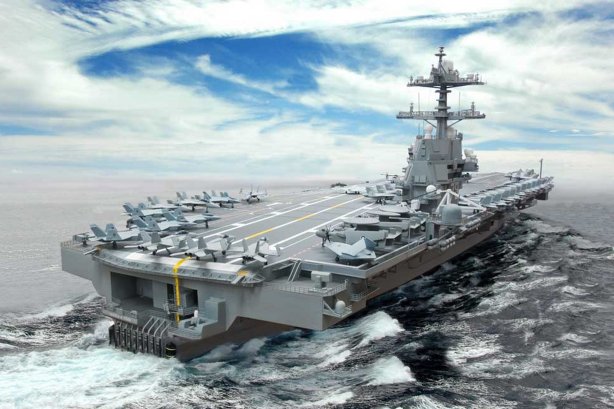With the US Navy due to accept its newest aircraft carrier, the USS Gerald R. Ford (CVN-78), in March 2016, reports have surfaced that the service has also ordered the second carrier, the USS John F. Kennedy (CVN-79), as well as placing a down payment for the third carrier in the Ford-class, the USS Enterprise (CVN-80).
Gerald R. Ford is intended to be the first of a class of aircraft carriers that offer significant performance improvements over the previous Nimitz-class aircraft carrier. Gerald R. Ford is equipped with an AN/SPY-3 active electronically scanned array multi-function radar, and an island that is shorter in length and 20 feet (6.1 m) taller than that of the Nimitz-class; it is set 140 feet (43 m) further aft and 3 feet (0.91 m) closer to the edge of the ship. Replacing traditional steam catapults, the Electromagnetic Aircraft Launch System (EMALS) will launch all carrier aircraft. This innovation eliminates the traditional requirement to generate and store steam, freeing up considerable below-deck square footage. With this EMALS innovation, Gerald R. Ford can accomplish 25% more aircraft launches per day than the Nimitz-class and requires 25% fewer crew members. The Navy estimates it will save $4 billion in operating costs over a 50-year lifespan.
Accord to Bloomberg Business, “The Pentagon’s top weapons buyer has approved awarding Huntington Ingalls Industries Inc. a contract valued at as much as $4 billion to start building the second in the new Ford class of aircraft carriers.
Frank Kendall issued a decision memo for the Navy to proceed with detailed design and construction of the USS John F. Kennedy and make a down payment on the third carrier in the $42.8 billion program. The memo, signed on Wednesday evening, was obtained by Bloomberg News.”
Unfortunately, some shortcomings have come to light regarding the capabilities of the new carrier. Earlier this year, it was revealed that the launching and landing systems on the Ford would place extra stress on aircraft, precluding the external fuel tanks needed for combat missions.


